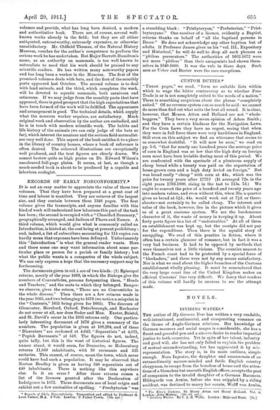RECORDS OF EARLY NONCONFORMITY.*
IT is not an easy matter to appreciate the value of these two volumes. That they have been prepared at a great cost of time and labour is manifest., They are octavos of the largest size, and they contain between them 1348 pages. The first volume gives the transcripts, and anyone familiar with this kind of work will understand how laborious this part of the task has been ; the second is occupied with a " Classified Summary," geographically arranged, and Indices of Places and Names. A third volume, which would give what is commonly called an Introduction, is hinted at, the cost being at present prohibitory ; and, indeed, a list of subscribers accounting for 114 copies can hardly mean that expenses have been defrayed. Unfortunately this "Introduction" is what the general reader wants. Here and there some one may want information about some par- ticular place or person for a parish or family history ; but what the public wants is a conspectus of the whole subject. We can only express a hope that the necessary support may be forthcoming.
The documents given in vol. i. are of two kinds : (1) Episcopal returns, mostly of the year 1669, in which the Bishops give the numbers of Conventicles, persons frequenting them, " Heads and Teachers;" and the sects to which they belonged. Bangor, we observe, gives the return, " There are no Conventicles in the whole diocese." Then there are a few returns made in the year 1665, and two belonging to 1676 (we notice a misprint in the " Contents," 1655 being given for 1665). The dioceses of Gloucester, Hereford, Oxford, Peterborough, and Rochester do not occur at all, nor does Sodor and Man. Exeter, Bristol, and St. David's occur in the 1665 returns only. One particu- larly interesting document of 1676 gives a summary of the numbers. The population is given at 108,294, and of these " Dissenters " are reckoned at 4,643, " Separatists " at 4,075, "Popish Recusants" at 548. The figures do not, indeed, quite tally, but this is the wont of historical figures. The names stand, it would seem, for Deaneries, so Malniesbury returns 11,869 inhabitants, with 10 recusants and 535
sectaries. have cannot, of course, mean the town, which never could have had such a population. It may be observed that Norton Bradley is given as having 340 separatists out of 440 inhabitants. There is nothing like this anywhere else. Is it an error P After these returns comes a list of the licences granted after the Declaration of Indulgence in 1672. These documents are of local origin and exhibit not a few curiosities of spelling. "Presbyterian " was
. ,
• Records of Dirty Nonconformity. Transcribed and edited by Professor G. L9011 Turner, M.A. 2 Vols. London : Fisher 17nwin. [Ws. net.]
a stumbling block : " Prisbyteryan," "Prebeterian," " Prist- beyteryane." One receiver of a licence, evidently a Baptist, returns thanks on behalf of " all the baptised persons in Dover." He does not acknowledge any other baptism but of adults. If Professor James gives us his " vol. III., Expository and Historical," be will do well to drop all such phrases as " pitiless persecutors." The authorities of 1662-1672 were not more " pitiless " than their antagonists bad shown them- selves in 1649-1660. It was the rule in those days. Such men as Usher and Baxter were the rare exceptions.


























































 Previous page
Previous page